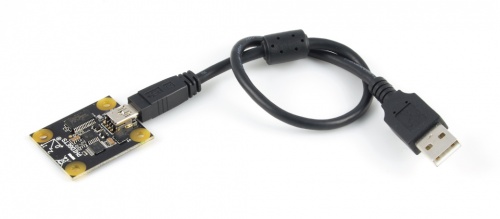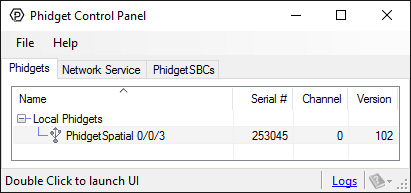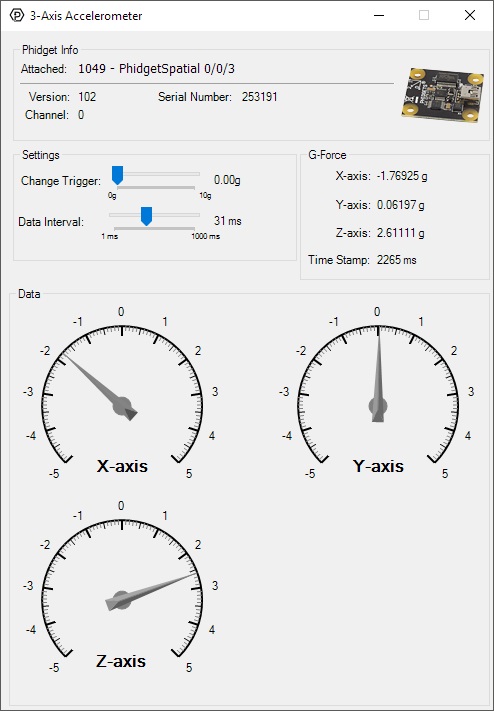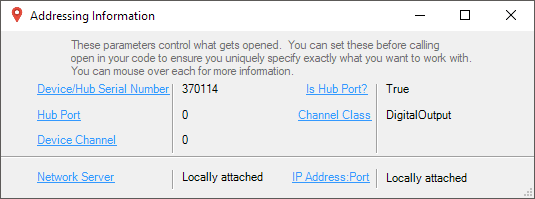Replaced by the 1043 - PhidgetSpatial 0/0/3 High Resolution.
The 1049 - PhidgetSpatial 0/0/3 measures static and dynamic acceleration in 3 axes, up to 5g, and provides a high sampling speed of up to 1000 samples per second.
Each accelerometer axis is calibrated at the factory for cross-axis misalignment, sensitivity to positive and negative acceleration, and offset.
The 1049 can be used to:
| Accelerometer | |
|---|---|
| Acceleration Measurement Resolution | 3.7 mg |
| Acceleration Bandwidth | 110 Hz |
| Acceleration Measurement Max | ± 5 g |
| Axis 0 Noise Level (X-Axis) | 2 mg |
| Axis 1 Noise Level (Y-Axis) | 2 mg |
| Axis 2 Noise Level (Z-Axis) | 2 mg |
| Board Properties | |
| API Object Name | Accelerometer |
| Sampling Speed Min | 1 s/sample |
| Sampling Speed Max | 1 ms/sample |
| Sampling Speed Min (Webservice) | 1 s/sample |
| Sampling Speed Max (Webservice) | 16 ms/sample |
| USB Voltage Min | 4.4 V DC |
| USB Voltage Max | 5.3 V DC |
| Current Consumption Max | 22 mA |
| USB Speed | Full Speed |
| Operating Temperature Min | 0 °C |
| Operating Temperature Max | 70 °C |
| USB Stack | HID |
| Driver Support | Phidget21, Phidget22 |
| Customs Information | |
| Canadian HS Export Code | 8471.80.00 |
| American HTS Import Code | 8471.80.40.00 |
| Country of Origin | CN (China) |
| Device | Object Name | Channel |
|---|---|---|
| 3-Axis Accelerometer | Accelerometer | 0 |
Welcome to the 1049 user guide! In order to get started, make sure you have the following hardware on hand:
Next, you will need to connect the pieces:

Now that you have everything together, let's start using the 1049!
In order to demonstrate the functionality of the 1049, the Phidget Control Panel running on a Windows machine will be used.
The Phidget Control Panel is available for use on both macOS and Windows machines.
To open the Phidget Control Panel on Windows, find the ![]() icon in the taskbar. If it is not there, open up the start menu and search for Phidget Control Panel
icon in the taskbar. If it is not there, open up the start menu and search for Phidget Control Panel
To open the Phidget Control Panel on macOS, open Finder and navigate to the Phidget Control Panel in the Applications list. Double click on the ![]() icon to bring up the Phidget Control Panel.
icon to bring up the Phidget Control Panel.
For more information, take a look at the getting started guide for your operating system:
Linux users can follow the getting started with Linux guide and continue reading here for more information about the 1049.
After plugging the 1049 into your computer and opening the Phidget Control Panel, you will see something like this:

The Phidget Control Panel will list all connected Phidgets and associated objects, as well as the following information:
The Phidget Control Panel can also be used to test your device. Double-clicking on an object will open an example.
Double-click on the Accelerometer object, labelled PhidgetSpatial 0/0/3, in order to run the example:

General information about the selected object will be displayed at the top of the window. You can also experiment with the following functionality:
Before you can access the device in your own code, and from our examples, you'll need to take note of the addressing parameters for your Phidget. These will indicate how the Phidget is physically connected to your application. For simplicity, these parameters can be found by clicking the button at the top of the Control Panel example for that Phidget.

In the Addressing Information window, the section above the line displays information you will need to connect to your Phidget from any application. In particular, note the Channel Class field as this will be the API you will need to use with your Phidget, and the type of example you should use to get started with it. The section below the line provides information about the network the Phidget is connected on if it is attached remotely. Keep track of these parameters moving forward, as you will need them once you start running our examples or your own code.

You are now ready to start writing your own code for the device. The best way to do that is to start from our Code Samples.
Select your programming language of choice from the drop-down list to get an example for your device. You can use the options provided to further customize the example to best suit your needs.
Once you have your example, you will need to follow the instructions on the page for your programming language to get it running. To find these instructions, select your programming language from the Programming Languages page.
For more information on testing and calibrating this device, check the Accelerometer Guide.
| Channel Name | API | Channel |
|---|---|---|
| 3-Axis Accelerometer | Accelerometer | 0 |
| API | Detail | Language | OS | |
|---|---|---|---|---|
| Accelerometer | Visual Studio GUI | C# | Windows | Download |
| Accelerometer | Objective-C | macOS | Download | |
| Accelerometer | Swift | macOS | Download | |
| Accelerometer | Swift | iOS | Download | |
| Accelerometer | Visual Basic | Windows | Download | |
| Accelerometer | Max | Multiple | Download |
| Date | Board Revision | Device Version | Comment |
|---|---|---|---|
| June 2010 | 0 | 100 | Product Release |
| June 2010 | 0 | 101 | setLabel fix |
| May 2011 | 0 | 102 | getLabelString fix for lables > 7 characters |
| April 2012 | Product Discontinued. Succeeded by the 1041 - PhidgetSpatial 0/0/3 Basic or the 1043 - PhidgetSpatial Precision 0/0/3. | ||